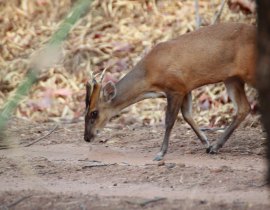Professional Pest Control & Wildlife Management
Muntjac Deer
Although this small alien to our shores is a welcome sight in many gardens the Reeves or Chinese Muntjac deer Muntiacus reevesi is becoming a serious pest - destroying flowers, plants and all vegetation in there wake. With no natural predators here in the UK and the ability to breed twice a year Muntjac deer are having something of a population explosion in East Anglia. They are often to be found on the grass verges of roads and all too often are the victims of traffic accidents.
The deer themselves are not much larger than a Labrador, weighing in between 10-18 kgs. The Bucks (males) have short antlers and also a set of tusks – overly large canine teeth, they are often recorded to have attacked pets when cornered. Early evenings Muntjac can be seen coming out of dense vegetation to feed, also known as the ‘barking deer’ due to their vocal calls to find mates and maintain territories.
If you would like to make an appointment, need advice or would like to ask us a question please use the enquiry form or call us on 01284 799 398.
-
Risks
Due to their reproductive rate numbers are on the increase. With no natural predators every year at least one new generation must find itself a territory, pushing them further into contact with people. Their stomaches seem keen to consume all manner of shrubs and flowers, with damage caused by Muntjac deer may run into hundreds of pounds worth of investment per garden.
Deer are not known for being aggresive however its not that uncommon to hear that Muntjac have charged and gored dogs if startled.
-
Treatment
Wildlife Proof Fencing is the long term solution to a Muntjac problem. Culling by a qualified marksman will reduce numbers in a local population and will provide relief until the numbers in the area recover. However, with a growing population the any culling will ulitmately create a vacuum. If the deer has found itself within a confined area and is unable to escape culling is not always an option. If the deer is a residential area the use of fire arms must be considered inappropriate.
We have developed our own deer nets for the live capture of injured muntjac deer. Working as team we capture the animal and place it in a specially made Muntjac crate to be removed for culling at an appropriate location.
If you would like to discuss a deer problem please feel free to call or email us.
-
Life Cycle
Does (female deer) can become pregnant at any time of the year and will produce a fawn every seven months – coming into season a few days after giving birth. The young fawns follow their mother around feeding on her milk for upto two months before weaning, they become independent at six months old and will become sexually mature at just eight months old.
With a life span of up around 15 years it is clear as to why Muntjac are becoming such a nuisance, being very territorial a ‘tide line’ of damage to woodland and garden plants become apparent after a short time.
-
Pest Info
Related
- False Widow Spider Removal
- Cluster Fly help
- The trouble with fleas?
- Mole Catching in Suffolk
- Rats in the Garden
- Wasp Nest Control
- Rats in your chicken Coop
- Anaphylaxis
- Bee Swarms
- Becoming a Beekeeper
- Rare Breed Poultry
- Pest Control with Birds of Prey
- Un-marked vehicles available
- Rabbiting with Ferrets
- Myxomatosis
- Poll-Tex Mesh
- Honorary Member Russell Wallis
- Free Rabbit Control



